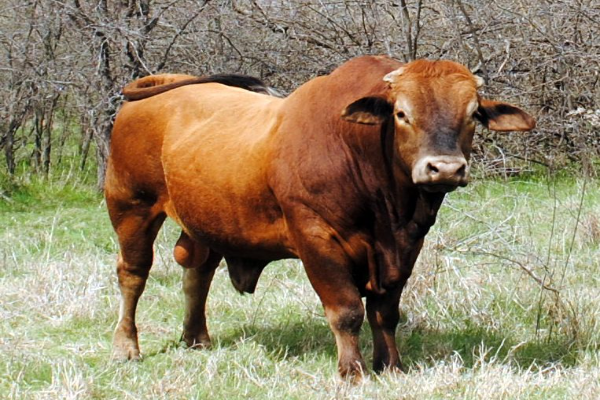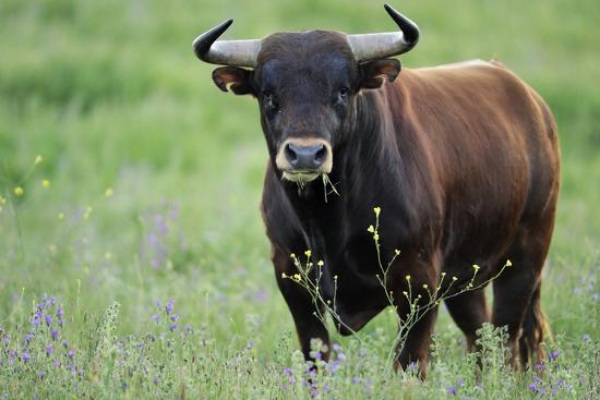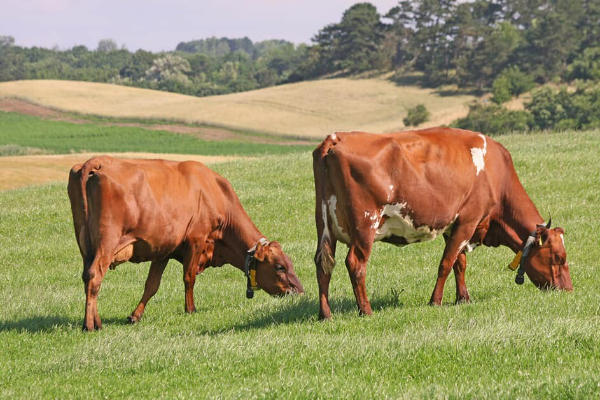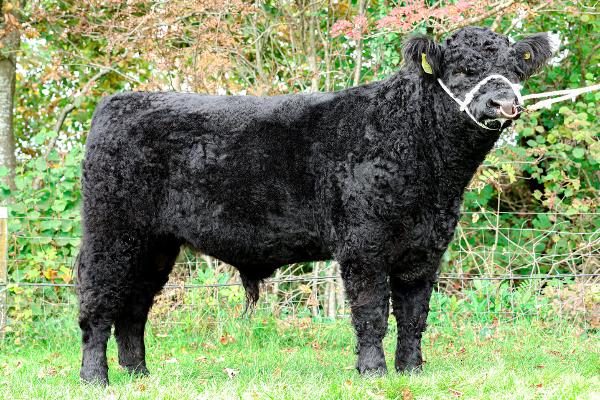Canadian Highland Cattle
What is the History of Canadian Highland Cattle?
Highland Cattle originated in the Highlands and west coastal islands of Scotland, areas severe in climate and lashed by the North Atlantic gales.
Throughout the long recorded history of Highlands, breeders have taken great care to retain the original characteristics of these cattle. Originally, the breed was divided into two classes, the West Highlander or Kyloe and the Highlander. The Kyloes, raised on the western islands of Scotland, tended to be of a smaller size and had a higher percentage of black and brindled cattle than the mainland Highlanders. The size difference was more probably due to the more severe climate and limited rations that the island cattle were subjected to than a genetic variation between the classes. Today all members of the breed are called Highland.
Highland Cattle were first imported into Canada from Scotland in the 1880s: one bull by the Hon. Donald A. Smith (Lord Strathcona), Winnipeg, and one bull by Robert Campbell, Strathclair, Manitoba, who later also imported five females. History has also recorded the presence of Highland Cattle in Nova Scotia during these early years.
The late 1920s began the era significant to present day Canadian breeders, when importations were made from Scotland by breeders in Saskatchewan and Ontario. R. Home Smith of Toronto imported one female and W.A. McInroy of Ilderton, Ontario, imported two females and a male in 1928. In 1929, Mary Lindsay imported six females and one male to Greenstreet, Saskatchewan, and later that year R. Home Smith imported four more females and one male.
Since that time there have been many more importations, some of which were on a much larger scale of between 10-40 animals. In the early 1950's importing and exporting of Highland Cattle started between Canada and the United States.
The Canadian Highland Cattle Society was formally incorporated as a livestock breed association under the Livestock Pedigree Act in October 1964. From that time to the present, the Canadian Highland Cattle Society has employed the services of Canadian Livestock Records Corporation to verify and record the pedigrees of all registered Canadian Highland Cattle.
All Highlands registered in the Canadian Herd Book must be purebred. By not allowing the addition of other breeds to the Canadian Highland gene pool, the Canadian Highland Cattle Society maintains the purity of the race.
Canadian cattle have always had an excellent health record. This factor, along with the present worldwide demand for Highland Cattle, has led to a number of exports of Canadian Highlands and Highland embryos to countries such as Australia, New Zealand, Denmark, Germany and even Scotland.
What are the Characteristics of Canadian Highland Cattle
Highlands have a double coat of hair - a downy undercoat and a long outer coat which may reach 13 inches, and which is well-oiled to shed rain and snow. With the double coat of hair and thick hide, the Highland has been adapted by nature to withstand great exposure. It is not uncommon for Highlands to shed this heavy hair coat when exposed to a hot dry climate and then grow a new one as the damp cold weather returns.
They have long horns and long, wavy, woolly coats that are coloured red, ginger, black, dun, yellow, white, grey, "silver" (white but with a black nose and ears), or tan, and they also may be brindled.
Their skill in foraging for food allows them to survive in steep mountain areas where they both graze and eat plants that many other cattle avoid. They can dig through the snow with their horns to find buried plants.
Highlands have the ability to adapt to a more hostile environment, grazing in poor or abandoned pastures. This strength is definitely an advantage for farmers wishing to produce beef under more arduous conditions using natural inputs. However, to maximize the performance of their livestock, encourage maximum development and maintain good health farmers will benefit by providing the animals with a healthy diet that ensures an adequate supply of minerals and nutrients and to provide a comfortable environment. The Highland's proven ability to produce top quality meat without the addition of expensive high quality feed makes this breed the perfect choice for farmers who wish to produce beef on a forage diet. To do this successfully an adequate ration must be provided to allow for a growth rate of approximately 2 lb/day right up to slaughter. Rotational grazing is one method which has been shown to achieve these results.
Mating occurs throughout the year with a gestation period of approximately 277–290 days. Most commonly a single calf is born, but twins are not unknown. Sexual maturity is reached at about eighteen months. Highland cattle also have a longer expected lifespan than most other breeds of cattle, up to 20 years.
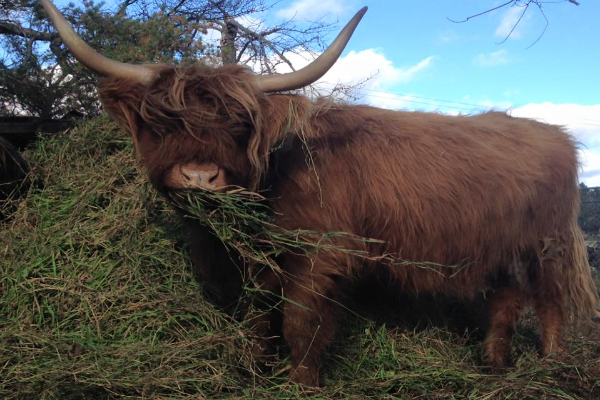
Mothering instinct is highly developed in the Highland cow. Abandoned calves, even for first-calf heifers, are rare. This strong protective inclination of the cow minimizes predator losses that can even extend to sheep that are pastured in the same field. The Highland calf is exceptionally hardy and grows rapidly up to weaning. The Highland cow has a long productive life and many herds average 12 calves from each cow. This greatly reduces their replacement cost, a most important factor these days.
They have a docile temperament and the milk has a high butterfat content, so have traditionally been used as house cows. They are generally good-natured animals but very protective of their young.
All European cattle cope relatively well with low temperatures but Highland cattle have been described as "almost as cold-tolerant as the arctic-dwelling caribou and reindeer". Conversely due to their thick coats they are much less tolerant of heat than zebu cattle, which originated in South Asia and are adapted for hot climates. Highland cattle have been successfully established in countries where winters are substantially colder than Scotland such as Norway and Canada.
The cattle have a clear structure and hierarchy of dominance, which reduces aggression. Social standing depends on age and sex, with older cattle being dominant to calves and younger ones, and males dominant to females. Young bulls will dominate adult cows when they reached around 2 years of age. Calves from the top ranking cow were given higher social status, despite minimal intervention from their mother. Playfighting, licking and mounting were seen as friendly contact.
The meat of Highland cattle tends to be leaner than most beef because Highlands are largely insulated by their thick, shaggy hair rather than by subcutaneous fat. Highland cattle can produce beef at a reasonable profit from land that would otherwise normally be unsuitable for agriculture.
What is the Weight of Canadian Highland Cattle?
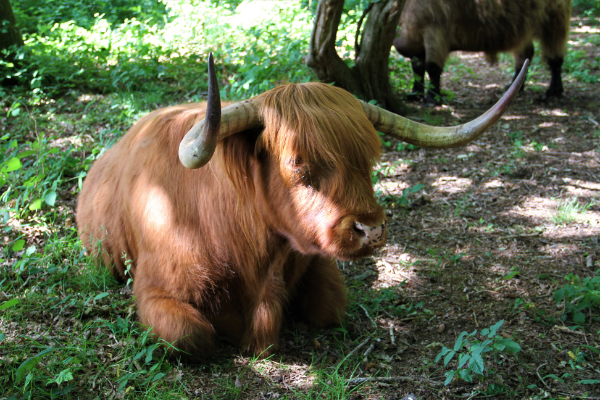
Mature bulls weigh 1,800 pounds (800 kilograms) in breeding condition.
Mature cows weigh 1,100 pounds (500 kilograms) in breeding condition.
References :
chcs.ca
https://en.wikipedia.org
afs.okstate.edu
https://www.omicsonline.org
http://www.highlandcattleworld.co.uk/

Written by
Murat KANAT
Veteriner HekimBreedsMore
IllnessesMore
Forage cropsMore
![]() Патологическая физиология голодания Arina TARAN
Патологическая физиология голодания Arina TARAN![]() Дефицит фосфора (гипофосфатемия) Hipofosfatemi Arina TARAN
Дефицит фосфора (гипофосфатемия) Hipofosfatemi Arina TARAN![]() Какие бывают кормораздатчики для ферм КРС? Irina Makarova
Какие бывают кормораздатчики для ферм КРС? Irina Makarova![]() Кормушки для овец Diana Myakisheva
Кормушки для овец Diana Myakisheva![]() Питание домашних коз: что едят, виды корма и правила кормления Alina Arslantürk
Питание домашних коз: что едят, виды корма и правила кормления Alina Arslantürk![]() Важность минералов питании сельскохозяйственных животных Irina Makarova
Важность минералов питании сельскохозяйственных животных Irina Makarova



